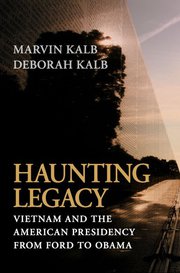Q&A with James Reston Jr.
 Friday, September 29, 2017 at 7:01AM
Friday, September 29, 2017 at 7:01AM James Reston Jr., photo by Susan RainesJames Reston Jr. is the author of the new book A Rift in the Earth: Art, Memory, and the Fight for a Vietnam Memorial. His many other books include The Conviction of Richard Nixon and Warriors of God, and his work has appeared in The New Yorker, Vanity Fair, and a variety of other publications. He lives in Chevy Chase, Maryland.
Q: You write, "The roots of this book reach back to my own service in the U.S. Army (1965-1968)..." Why did you decide to focus on the Vietnam War Memorial in your new book, and what impact did your own service have in inspiring the book?
A: There are two emotional roots for The Rift in the Earth. The first is that I have a friend on the Wall, who trained with me in Army Intelligence in 1965-66, and who was killed on the first day of the Tet Offensive in the city of Hue on Jan. 30, 1968. His story is told in the last chapter of the book.
The brilliance of Maya Lin’s Wall is that the survivor views the name of his dead comrade as his own image is reflected in the black granite. The death of Ron Ray could easily have been my death.
The second is my friendship with the late Frederick Hart, the sculptor of the three soldiers at the Memorial. I sent long hours talking to him in the 1990s about the “art war” over Maya Lin’s design in which he was a central player.
Q: How would you characterize the dynamic between architect Maya Lin and sculptor Frederick Hart?
A: Bitter. Maya Lin was the winner against 1,420 competitors in a very professional artistic contest. It was, at the time, the largest artistic competition for a piece of public art in the history of American and European art.
The judges of the contest were highly distinguished luminaries in the world of American art and architecture. And so there was a fundamental moral principle about the sanctity and inviolability of a winning design.
But because this was public art, in which agencies of the U.S. government had to accept and certify a work of public art for the most sacred space in Washington, the National Mall, the process was in part political.
When there was a ferocious backlash about Lin’s design for the blackness of its granite, for being underground, for displaying only the names of the dead with no mention of the sacrifice, service, and occasional heroism of those who fought, a compromise became necessary. As a brilliant figurative artist, Hart was the beneficiary.
Lin was horrified at the notion of an entirely different style of art being imposed upon her work. It was an immoral violation of her work, and she was supported by the artistic and architectural community. But Congress and the White House imposed Hart’s statues on the Wall as a way of saving the Memorial.
Hart, in turn, was contemptuous of Lin’s objections, and felt he was the savior of the Memorial. In his testimony during the art war, he was deferential to her winning design. But, in his sharper moments, he referred to her as an “ingénue.”
Q: How was the book's title chosen, and what does it signify for you?
A: “A rift in the earth” is a phrase from Maya Lin’s description of her vision for her work in the Memorial competition. It was her words, more than the simple, almost high-schoolish drawing of her chevron, that won her the big prize. Her handwritten words were moving and poetic, and they captivated the judges.
But I see that phrase in a larger context, as the rift in the entire Vietnam generation, that was divided passionately into different, warring, factions between those who served in Vietnam and those who either protested or avoided service altogether.
No future American generation must ever again face the moral dilemma of the Vietnam generation.
Q: What role would you say the Memorial plays today?
A: The vicious fight over the building of a Vietnam Memorial is now largely forgotten, as the Wall and Hart’s statutes are universally embraced.
But something magical has happened with time. The Wall is no longer a “veterans” memorial but a memorial for the entire Vietnam generation. It is equally welcoming to pacifists as to warriors.
Nor is it any longer just about the Vietnam War, but about all wars. And it is broader still. To see parents bring their young children by the thousands to the Wall is to realize that the Memorial is for all generations, as we contemplate the ultimate cost of any war.
Q: What are you working on now?
A: I’m returning to a 9/11 novel that I began some years ago.
--Interview with Deborah Kalb. This Q&A also appears on deborahkalbbooks.blogspot.com.


Reader Comments